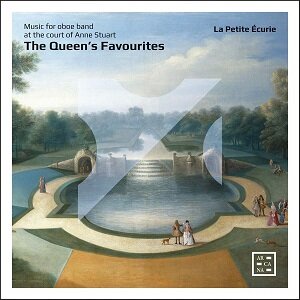
The Queen’s Favourites – Music for oboe band at the court of Anne Stuart
James Paisible (1656-1721)
Suite in C
Thomas Morgan (fl. 1691-1699)
Overture in G minor
Henry Purcell (1659-1695)
Suite Angloisse (from The Fairy Queen, Bonduca & King Arthur)
James Paisible
Prelude IV in G minor
The Queen’s Farewell
Gottfried (Godfrey) Finger (c1655-1730)
Overture in F
La Petite Écurie
rec. 2021, Veranstaltungszentrum Rudolfsheim, Vienna
Arcana A527 [68]
Ensembles of instruments of the same family at different pitches are a common phenomenon throughout music history. The two ensembles that are still part of our music scene are the consort of viols and the recorder consort. Less commonly known are consorts of transverse flutes, violins or lutes. What they all have in common is that they have their roots in the renaissance. In comparison the kind of ensemble that is the subject of the present disc is a relatively modern phenomenon. The oboe was invented in France under the reign of Louis XIV, and an ensemble of oboes – known as bande des hautbois – made its appearance at the French court. Given the fascination of everything French in some aristocratic circles across Europe, it soon was exported to other countries. This was also due to the fact that quite a number of oboists and makers of oboes were Protestants, who fled France when the Edict of Nantes was revoked.
The programme that La Petite Écurie has recorded, comprises music written by English composers. In England the entrance of this kind of ensemble was due to Charles II, who had spent the period of the Interregnum in France, where he had become acquainted with the latest trends in music. He was keen to introduce them in England after the Restoration in 1660. Part of that was the foundation of the Twenty-four violins, modelled after Louis XIV’s Vingt-quatre violons. Ann Allen, in her liner-notes, mentions that “when Robert Campbell arrived in London in the 1670s, with a band of French oboists, this new style of double reed instrument quickly became a hit and oboe bands became a part of the new musical landscape.” (Unfortunately, she does not inform the reader who Campbell was. He is not mentioned in New Grove).
One of the French oboists was Jacques Paisible, who was called James in England. He became the principal court composer of Anne Stuart, queen from 1702 to 1714. He was a virtuosic wind player and was a member of Anne’s oboe band, which she kept well before she ascended the throne, and which participated in the performance of music at various royal balls. The oboe band included some other French players, such as Charles Babell (father of William Babell, who arranged some of Handel’s opera arias for harpsichord), but also increasingly English-born players. Now and then the oboists were joined by the court trumpeter John Shore (who had played some of Henry Purcell’s most difficult trumpet parts).
The largest part of the repertoire played by La Petite Écurie is taken from a set of four partbooks which was probably put together by Paisible, apparently in the 1690s. The pieces bear French titles, reflecting the French origin of Paisible and many players in the band at that time. The music is from the pen of Paisible himself, but also from, among others, Purcell, Pascal Colasse and Gottfried (Godfrey) Finger. The longest work is a Suite Angloisse, which consists of music from three theatrical works by Purcell: The Fairy Queen, King Arthur and Dioclesian. In this recording the pieces from the latter work have been omitted, and replaced by excerpts from Bonduca, which appear elsewhere in the partbooks. Paisible is responsible for The Queen’s Farewell, which was originally part of the funeral music for Queen Mary in 1695. The least-known composer in the programme is Thomas Morgan, an organist who may have been Irish. Only a few songs and instrumental works of his pen are known.
Recordings of music for oboe band have been released in the past, but these mostly comprised music from the continent, in particular France. This may be the first time English repertoire for an oboe band has been recorded. At least I can’t remember having heard any of that before. That makes this disc an important addition to the discography, which opens a chapter in music history that is little-known.
An issue that needs to be discussed is the participation of percussion. In the booklet, Philipp Lamprecht writes: “In that period, it was common for a drummer to improvise along with the wind instruments, particularly in military music. Given that improvisation was a common performance practice – particularly in theatres, operas and outdoor festivities – the only notation which is extant, is to be found in marching music and occasional Aires.” From this perspective, the involvement of percussion is justified. Fortunately, it is not used indiscriminately; there are also movements without percussion. However, as Lamprecht indicates, it was used in specific circumstances. It would have been useful if the performers had indicated which circumstances they imagined while playing the music. The first movement from King Arthur opens with a timpani solo of about 88 seconds. In the suite by Purcell at some moments a wind machine is used. Both decisions seem debatable. However, it hardly matters in the light of this recording as a whole.
The playing of La Petite Écurie is excellent, and does full justice to the character of the music. The result is a highly entertaining disc to which the lover of wind music will regularly return. It is to be hoped that this part of English music history is going to receive more attention than it has been given to date.
Johan van Veen
www.musica-dei-donum.org
twitter.com/johanvanveen
Help us financially by purchasing from





















